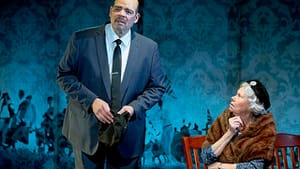Stay in the Loop
BSR publishes on a weekly schedule, with an email newsletter every Wednesday and Thursday morning. There’s no paywall, and subscribing is always free.
The truth behind the fiction
‘Driving Miss Daisy’ in Ambler

Driving Miss Daisy, Alfred Uhry’s bittersweet depiction of two reviled minority groups over the course of 25 years in the Deep South, is based on the playwright’s real Jewish family. This production by Act II Playhouse captures that domestic 1950s Georgia feeling better than any other I’ve seen.
The competition was daunting. Just last year I caught Angela Lansbury and James Earl Jones in a fine production. And most of us have seen Jessica Tandy and Morgan Freeman in the 1989 movie version. So what lifts the new Act II Playhouse production production to preeminence?
Part of it is the intimacy of the theater in Ambler, which is only nine rows deep. The other is the superlative acting of Carla Belver as the retired Jewish teacher Daisy Werthan, Brian Anthony Wilson as her black driver Hoke Colburn, and Tony Braithwaite as Daisy’s son Boolie. Their interpretations are soft-spoken, low-key and believable, rather than star turns, and all three benefit from innovative staging by James J. Christy.
Surely Uhry and his family— originally from Atlanta and now living in New York— would love this production. I say that with some confidence because I’ve known them personally.
Uhry’s maternal grandmother was Miss Daisy, actually named Lena, born in Atlanta in 1877. Alfred’s Uncle Sig owned the Atlanta pencil factory that employed Leo Frank, a young Jewish relative from New York. When a local girl was found murdered in their warehouse in 1913, Frank— an outsider as well as a Jew— was falsely accused and convicted of raping and killing her. Before his appeal could be heard, an anti-Semitic mob dragged him from his cell and lynched him— the subject of Uhry’s 1998 musical Parade.
No Sabbath candles
For years afterward, Alfred once told me, his parents and other relatives were afraid to go out at night. To avoid detection, they bent over backwards to assimilate into Southern culture: They lit no Sabbath candles, spoke no Hebrew or Yiddish, wore no yarmulkes, and never had a seder or a bar mitzvah.
Alfred belonged to The Temple, a reform congregation founded by Atlanta’s German Jews, who shrank from association with their unwashed immigrant brethren from Eastern Europe. This strange hierarchy is referenced in Uhry’s script for Driving Miss Daisy. In his original text, when Daisy hears that someone bombed the Temple, she remarks, “Well, it’s a mistake. I’m sure they meant to bomb one of the conservative synagogues or the orthodox one. The Temple is Reform; everybody knows that.”
To which Hoke responds: “A Jew is a Jew to them folks. Just like light or dark, we all the same nigger.”
Many directors have excised those lines, perhaps because they’re excessively Jewish-oriented. Christy, to his credit, has retained them.
The schism is also revealed when Miss Daisy wants to attend a 1964 dinner honoring Martin Luther King. Boolie prefers that neither he nor his mother go, for fear that white gentile Atlantans will hold it against them. He talks about the little ways by which they will ostracize him and his business; again he draws parallels between whites’ differing attitudes towards different types of Jews and different types of blacks.
Unlikely friends
It is no coincidence that the play begins in 1948, the year that liberal Democrats from the far North (like Hubert Humphrey of Minnesota) first agitated at a national convention for Negro rights, and the Missouri-born Harry Truman desegregated the U.S. armed forces. (Christie adds a radio that lets the audience hear music and news reports that reflect the the changes in the world beyond Georgia.)
Daisy is a strong-willed woman of 72 who has crashed her car, so her son decides to hire a chauffeur. He employs Hoke, a 60-year-old African-American man. Daisy resents Hoke’s presence, and each of them display racial and religious prejudices. But over the course of the next two decades Daisy gradually comes to appreciate Hoke. In one of the most touching scenes, she teaches Hoke to read; in another, both bond over friends and relatives who were lynched. By the final curtain, Daisy has come to see Hoke as her best friend.
Physical changes
Belver is a distinguished actress who won a Barrymore Award last year for her lead role in Act II’s The Glass Menagerie. Her performance here is even better. It’s touching to see Daisy age before our eyes, her hands trembling, her face drooping until, in 1973, she is 97 years old. By the same token, Wilson as Hoke evolves from A 60-year-old tower of strength to a hesitant 85-year-old for whom each step is painful. The subtlety required in portraying such physical changes is possible only a tiny space like Act II Playhouse.
Braithwaite’s contribution is significant as well, demonstrating patience and humor in dealing with his feisty mother, while guardedly showing his love by kissing her on the top of her head.
John Stovicek’s sound effects made a major contribution to this production, as did James Leitner’s lighting and Frankie Fehr’s costumes.
What, When, Where
Driving Miss Daisy. By Alfred Uhry; James J. Christy directed. Through March 26, 2016 at Act II Playhouse, 56 E. Butler Avenue, Ambler, PA. (215) 654-0200 or act2.org
Sign up for our newsletter
All of the week's new articles, all in one place. Sign up for the free weekly BSR newsletters, and don't miss a conversation.
 Steve Cohen
Steve Cohen